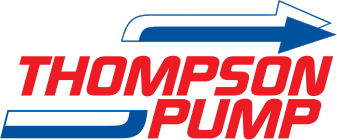Thompson Pump’s Rapid Response Halts Sewage Overflow Catastrophe

What began as an otherwise nondescript Thursday afternoon in mid-February of 2017 near Washington D.C. ended with an unexpected catastrophe. A 20-inch cast iron pressurized sewer main ruptured at a Maryland wastewater treatment plant.
The Washington Suburban Sanitary Commission (WSSC) and Maryland Department of Environment (MDE) were called in, as were emergency maintenance crews employed by the wastewater treatment plant, and Ross Contracting, Incorporated. Everyone quickly came to the consensus that this was a much larger issue than they could fix by themselves; this was going to be a serious multi-day repair requiring outside help and some heavy machinery. Enter Florida-based Thompson Pump Manufacturing Company, manufacturer of top-quality pumps and related equipment that also provides engineering expertise for construction dewatering and bypass.
Upon arrival, Thompson Pump determined the flow of the treatment plant was 12 MGD based on the existing conditions. The company mobilized four (4) Thompson 8” dry prime pumps with the Thompson Enviroprime System® and 1,200 lineal feet of 8-inch Quick Connect Pipe that allowed crews to route the wastewater into a nearby overflow/retention lagoon.
This was a major victory by anyone’s standards, but the solution was only temporary. That’s because the wastewater continued flowing and within a day, the retention/overflow lagoon was already close to maximum capacity. The Thompson Pump team deployed five (5) additional Thompson 6” dry priming pumps with the Enviroprime System® to pump the contents of the first overflow lagoon into a second one, increasing the holding capacity of the sewer.
While this was another milestone achieved, it was also another short-term solution. Before anything could even be repaired, the existing sewer lines needed to be inspected to allow the team to understand the extent of damage that occurred in the line. The engineers and the contractor concluded that the construction of a 30 MGD pump-a-round was needed to allow for the inspection and repair of the existing sewer line.
The Thompson Pump team met with all involved and the decision was made to begin the construction of the bypass immediately. Pumps and pipe would need to be installed, thereby diverting the sewage flow from the influent pump station to the grit facility.
The next morning, the massive multi-day undertaking began. Six (6) Thompson 12” dry prime pumps with the Enviroprime System® and three (3) discharge lines (each measuring 2,000 lineal feet) were mobilized. A forklift, two (2) Bobcats and two (2) fusion machines were brought in. Light towers were set up to ensure the safety of the workers, who were routinely working deep into the night.
All three (3) of Thompson’s discharge lines/pipes were installed above ground. This part of the process was completely trenchless allowing the team to complete the project in a shorter time frame. From beginning to end, the Thompson Pump and Ross crew operated the pumps around the clock, monitored the system and fueled the equipment being used to perform the bypass. The project lasted about 30 days without disruption.
Pump technicians were charged with conducting hourly checks, allowing them to promptly spot any irregularities; and quickly and efficiently fix mechanical issues and release the occasional clog. In addition to installing the 16 dry prime Enviroprime System® pumps with Silent Knight® sound enclosures used to pump the sewage and the 8,000 lineal feet of pipe and hose, it took thousands of man hours to install, operate and tear down the project.
